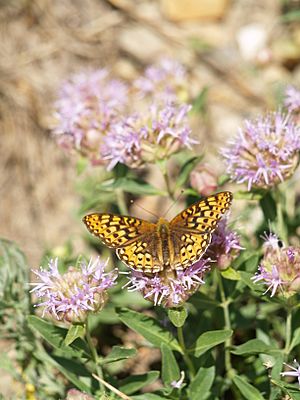Great Basin fritillary facts for kids
Quick facts for kids Great Basin fritillary |
|
|---|---|
 |
|
| Scientific classification |
The Great Basin fritillary (scientific name: Speyeria egleis) is a type of butterfly. It is also known as the egleis fritillary. This butterfly is part of the Nymphalidae family, which includes many well-known butterflies.
You can find the Great Basin fritillary in North America. Its range stretches from North Dakota southwest through Oregon to California. It also lives south into Colorado. These butterflies prefer certain places to live. They like mountain meadows, open areas in forests, and rocky ridges that are exposed to the sun.
What it Looks Like
The Great Basin fritillary is a medium-sized butterfly. Its wingspan is usually between 45 and 60 millimeters. That's about 1.8 to 2.4 inches wide. The wings are a bright to dull orange-brown color. They have distinct dark markings all over them. Adult butterflies are usually seen flying from late June through August.
Life Cycle and Food
Like all butterflies, the Great Basin fritillary starts its life as a tiny egg. The eggs hatch into larvae, which are caterpillars. These caterpillars need specific plants to eat. They feed on the leaves of different types of Viola species. These plants are also known as violets. Some of the violet species they eat include V. adunca, V. nuttallii, V. purpurea, and V. walteri.
Different Types of Great Basin Fritillaries
Within the Great Basin fritillary species, there are several different groups. These groups are called subspecies. They are all the same species but have slight differences. These differences might be in their appearance or where they live. For example, S. e. egleis is the main type. Other subspecies include S. e. albrighti, found in Montana, and S. e. linda, found in Idaho. There are many other subspecies found across its range.

